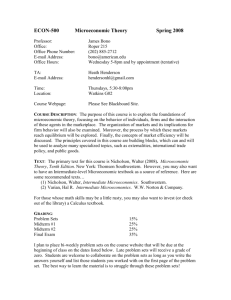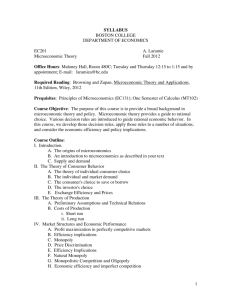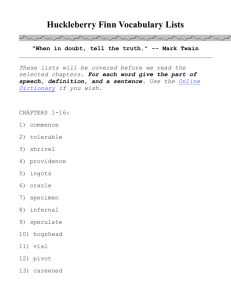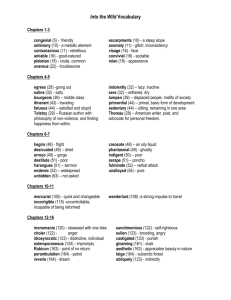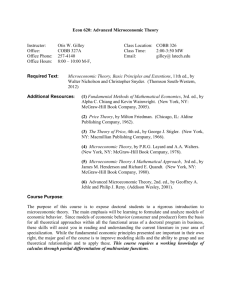university of ottawa - Université d'Ottawa
advertisement
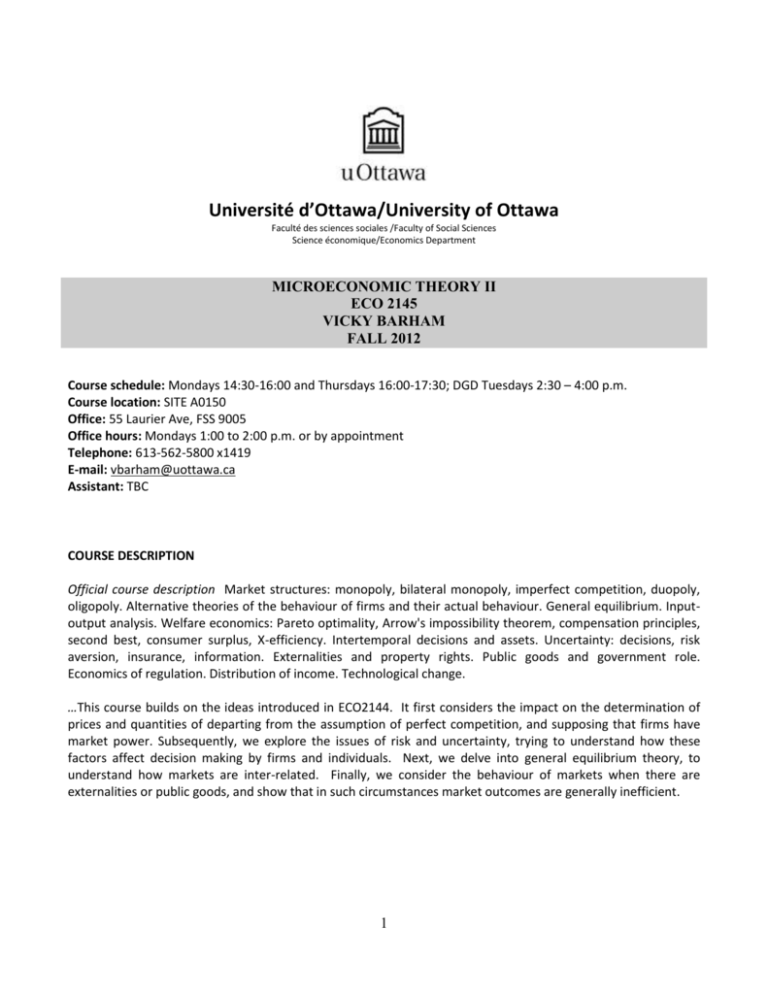
Université d’Ottawa/University of Ottawa Faculté des sciences sociales /Faculty of Social Sciences Science économique/Economics Department MICROECONOMIC THEORY II ECO 2145 VICKY BARHAM FALL 2012 Course schedule: Mondays 14:30-16:00 and Thursdays 16:00-17:30; DGD Tuesdays 2:30 – 4:00 p.m. Course location: SITE A0150 Office: 55 Laurier Ave, FSS 9005 Office hours: Mondays 1:00 to 2:00 p.m. or by appointment Telephone: 613-562-5800 x1419 E-mail: vbarham@uottawa.ca Assistant: TBC COURSE DESCRIPTION Official course description Market structures: monopoly, bilateral monopoly, imperfect competition, duopoly, oligopoly. Alternative theories of the behaviour of firms and their actual behaviour. General equilibrium. Inputoutput analysis. Welfare economics: Pareto optimality, Arrow's impossibility theorem, compensation principles, second best, consumer surplus, X-efficiency. Intertemporal decisions and assets. Uncertainty: decisions, risk aversion, insurance, information. Externalities and property rights. Public goods and government role. Economics of regulation. Distribution of income. Technological change. …This course builds on the ideas introduced in ECO2144. It first considers the impact on the determination of prices and quantities of departing from the assumption of perfect competition, and supposing that firms have market power. Subsequently, we explore the issues of risk and uncertainty, trying to understand how these factors affect decision making by firms and individuals. Next, we delve into general equilibrium theory, to understand how markets are inter-related. Finally, we consider the behaviour of markets when there are externalities or public goods, and show that in such circumstances market outcomes are generally inefficient. 1 PREREQUISITES The prerequisite for this course is ECO2144. If you did not pass Micro I, you will be automatically deregistered from Micro II. (And, yes, I know that you can re-register, but you will again be automatically deregistered.) REQUIRED COURSE MATERIALS Besanko, David and Ronald R. Braeutigam. Microeconomics, 4th edition. Hoboken, NJ: John Riley and Sons, Inc., 2008. Rockett, Catherine. Study Guide to Accompany Microeconomics Third edition by David Besanko and Ronald R. Braeutigam. Hoboken, NJ: John Riley and Sons, Inc., 2008. Both textbook and study guide are available at Agora Bookstore and Internet Café, 145 Besserer street. The two items can be purchased as a package deal, or they can be purchased individually. With the purchase of the textbook you will be given a registration code that will allow you to access online resources, i.e. eGrade Plus. It provides an online version of the text, interactive simulations and some problems with their respective solutions. Note: eGrade Plus, which includes an electronic version of the text, can be purchased separately or with the study guide. There is very little substantive difference between the 4th edition and previous editions. I will provide end-ofchapter problem guidance for both the 3rd and 4th editions. You will also need to use chapters 10 and 11 of Intermediate Economics by Hal Varian. These are available as a .pdf on the course website. EVALUATION Mideterm 1: October 4 – covers chapters 11 + 12 Midterm 2: November 5 – chapters Final exam (not cumulative: 1h20min) Graded homework (2 x 5%) 30% 30% 30% 10% No make-up exams or extra assignments will be provided for student who do poorly. Homework is due in class; any homework submitted late is assigned a grade of 0. Unless you can present a valid medical certificate, you will receive a grade of 0 should you miss any exam or quiz. PROBLEM SETS + TUTORIALS As you may be aware, ECO2145 is a course which has proven difficult for a significant proportion of our undergraduate students. Moreover, students who earn less than a C grade are unlikely to pass ECO3153. So, 2 this year the department has decided to try something new to support student learning – and we will be looking for your feedback on the different strategies we are implementing. The cornerstone of our new approach is the introduction of 6 problem sets. These will be posted according to the schedule indicated below. Each student in the class has been assigned to one of three different tutorial groups (they each meet in the same time slot), and you will also be expected to attend tutorials on two of the problem sets. You will receive an e-mail sent to your uOttawa e-mail account indicating which tutorial group you are assigned to; you may also check with me after class. You are not permitted to attend tutorials except according to the schedule indicated below. You will also be required to submit two of these problem sets for grading (see schedule below). All students will have access to the solutions for the problem sets, which will be posted on the class website following the tutorial. (This is why no homework will be accepted late.) If for any reason – including illness - you cannot attend class when your homework is due, you must make arrangements to submit it beforehand. PROBLEM SET DISTRIBUTION DATE September 10, 2012 Monopoly September 17, 2012 – Monopoly + price discrimination October 11, 2012 October 18, 2012 November 12, 2012 November 19, 2012 PROBLEM SET SUBMISSION DATE TUTORIAL DATE PROBLEM SET SOLUTIONS POSTED September 17: GROUP A MUST SUBMIT September 24: GROUP A MUST SUBMIT September 18: GROUP B MUST ATTEND September 25: GROUP B MUST ATTEND September 18, after 4:00 p.m. September 25, after 4:00 p.m. October 18: GROUP B MUST SUBMIT October 25: GROUP B MUST SUBMIT November 19: GROUP C MUST SUBMIT November 25: GROUP C MUST SUBMIT October 23: GROUP C MUST ATTEND October 30: GROUP C MUST ATTEND November 20: GROUP A MUST ATTEND November 26: GROUP C MUST ATTEND October 23, after 4:00 p.m. October 30, after 4:00 p.m. November 20, after 4:00 p.m. November 26, after 4:00 p.m. As part of the course evaluation process, we will be soliciting feedback from you on the effectiveness of the problem sets, and on whether you found the tutorials/graded homework to be helpful. Your frank evaluation of these tools will be taken very seriously. COURSE OUTLINE AND READING LIST Market Power Imperfect Competition and Strategic Behavior Risk and Information General Equilibrium Theory Externalities and Public Goods Chapters 11 and 12 Chapters 13 and 14 Chapters 15 Chapters 16 Chapter 17 3 LECTURE SCHEDULE Although I can’t be absolutely sure of how much material each lecture will actually cover, this is the tentative schedule. Chapter 11: September 6, 10, 13, 17. Chapter 12: September 20, 24, 27. Chapter 13: October 1, 11, 15. Chapter 14: October 18, 22 Varian – Chapter 10: October 25, 29 Varian – Chapter 11: November 1, 8 Chapter 15: November 12, 15 Chapter 16: November 19, 22, 26, 29 Chapter 17: December 3, 5. It is a rule of thumb that students need to see material at least three times before they start to achieve any degree of mastery. Moreover, seeing the material several times within a short time frame dramatically increases the speed of acquisition of new concepts. You are strongly encouraged to read through the relevant chapter before the lecture (first exposure), and to review the chapter again, making detailed notes for subsequent revision, within the 24 hour period that follows the lecture (third exposure). Once you have prepared your study notes, you should then try to work as many problems as possible. By following this disciplined approach, you will minimize the total amount of time that you actually have to spend studying microeconomic theory, and you will maximize your final grade. GENERAL COMMENTS Class notes will be posted on the class web site. I do not post the answers to the end-of-chapter problems. Students are greatly encouraged to try as many problems from the study guide (and textbook) as possible. If you would like to have your answers checked, you can hand them in to the T.A. He or she will also be holding regular office hours during the term. A FINAL WORD There is no such thing as a dumb question. (Well...at least, there are no dumb questions about microeconomic theory.) If you don’t understand something, ask me to try again. If you don’t ask questions, I will assume that my explanations are limpid, and that the pace and intensity of the course should be stepped up. And, finally, I love microeconomic theory. I derive tremendous intellectual satisfaction from studying theoretical models, and understanding how they work. I really hope that, by the end of the course, you will come to share my passion, and that you will also fall in love with the theory of general equilibrium. I have my fingers crossed! 4
